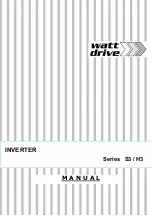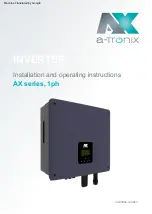
Copyright © 2012 CyberPower Systems, Inc.
Installation
3
CyperPower Grid Tie Solar Inverter
The CyberPower Grid Tie Solar Inverter is designed to convert solar
electric
(photovoltaic or PV) power into utility-grade electricity that can be
used by the
home or sold to the local power company.
Installing the inverter consists of mounting it to the wall and connecting
the DC input to a PV array and the AC output to the utility. See below
figure for a simple
diagram of a typical installation.
In order to operate, the inverter must have grid power available and
connected. It will not provide backup power if the AC grid fails.
Installation Options
The inverter may be installed as a single inverter, or in a multiple inverter
configuration.
For CPSPV5000ETL / CPSPV4000 ETL, only one PV array can be
connected to the inverter.
Single Inverter Installation
In this configuration, a single inverter collects the harvested solar energy
and route the power to the main utility service panel to be used by the
loads. Any surplus power not used by the loads will be directed to the
utility grid.
Multiple Inverter Installation
If multiple inverters are used, each inverter must be wired to an
independent PV array. In this configuration, each inverter collects the
harvested solar energy from a separate PV array and routes the power to
the main utility service panel to be used by the loads. Any surplus power
not used by the loads will be directed to the utility grid.
Planning the Installation
The following issues need to be considered when planning for an
installation using the inverter. See the specified sections for more
information.
-
Inverter Location?
-
PV Array Requirements?
-
Grounding Requirements?
-
Routing the wires?
Ensure that you have obtained all permits required by local authorities or
utilities before commencing installation.
Inverter Location
WARNING! Burn hazard
Do not install in a location where people can
accidentally come into
contact with the inverter. High temperatures can be present on the
inverter, causing a potential burn hazard.
In extreme condition, the inverter chassis can reach temperatures over
70
℃
(158
℉
), which can cause skin burns if accidentally touched.
Ensure that the inverter is located away from normal traffic areas.
Inverter failure due to improper installation will void the inverter warranty.
Consider the following when determining where to install the inverter.
Fire Safety
Do not install anywhere near combustible or flammable materials.
Indoor/Outdoor
The inverter uses a Type IP65-rated enclosure that can be mounted
indoors or outdoors.
Orientation
The inverter must be mounted vertically on a wall or pole. Do not mount
the inverter horizontally.
Temperature
Ensure that the inverter is mounted in a location where the ambient
temperature range is -20
℃
to +60
℃
. When the temperature is over
+40
℃
, the inverter may de-rate power.
Ground Clearance
Outdoors, the inverter requires at least 50 cm (19.7 inches) of clearance
between the bottom of the unit and the ground.
Indoors, it is recommended that the same clearance between the bottom
of the unit and the floor be used.
Distance
To minimize copper losses, ensure that wire lengths between the PV
array and the inverter and between the inverter and the Main Utility
Service Panel are kept to a minimum.
The maximum distances will depend on wire gauges and PV array output
voltages
Debris free
Excessive debris (such as dust, leaves, and cobwebs) can accumulate
on the unit, interfering with wiring connections and ventilation. Do not
install in a location where debris can accumulate (under a tree, for
example).
!





































